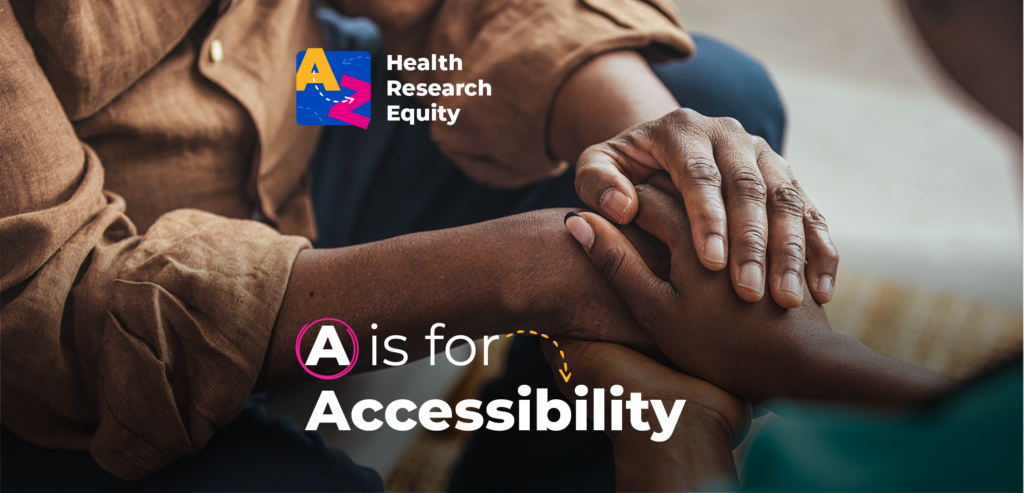Welcome to the first letter in our fortnightly A–Z of Health Research Equity series. If you haven’t read the introductory post and want to know more about this series, you can find out more here.
As you might expect, I’m kicking things off with the letter A. When taking notes for this series, I had lots of ideas for concepts important to health research equity that begin with the letter A. Accountability, Authenticity, Activism, and Action were all on my list. But I’ve chosen to focus on something that underpins all those concepts and more. Today, I’m talking about all things Accessibility.
What is Accessibility?
When you think of accessibility, the first thing that springs to mind may be a wheelchair user needing to use a ramp to access a building that hasn’t been designed with their access needs in mind. That is an accessibility need, but it’s a very narrow example of accessibility on the whole.
Type designer Bruno Maag discusses three pillars of accessibility: emotional, functional, and technical. He shares these pillars with typography in mind, but they can be applied to various settings, including clinical research.
- Emotional accessibility refers to the first impression a person experiences when presented with a product or service.
- Functional accessibility considers how a person understands and manages a product or service.
- Technical accessibility facilitates both functional and emotional accessibility, as it encompasses how physical and digital products and services are engineered.
Imagine you are viewing a website that provides information about a clinical study. The homepage shows a clear font in crisp white against a dark blue background, interspersed with images that accurately depict what it’s like to live with the condition the study is working to treat. Your immediate impression is positive, and you want to know more. You click around the site looking for more information. The cursor moves slowly, and you notice the text cut off, so you can’t read all the information available. The user experience is frustrating, so you click off the site and get on with your ever-growing to do list.
In this scenario, you began with a positive emotional accessibility experience. The functional and technical accessibility experiences that followed were so negative that they outweighed that initial positivity and stopped you from engaging further.
Accessible research is not based on one thing…I can’t even give you a checklist of things you should focus on. Any such checklist would be generic and inadvertently miss people out. Instead, I think it’s more effective to share ideas on how to approach your thoughts and discussions on accessibility.
Here are my top 4 tips for improving the accessibility of your research:
- Educate your team
Your entire team, whether researchers or other team members, should be well-versed in various facets of accessibility. Establishing a supportive and sensitive environment for both participants and team members all starts with training.
Encourage open dialogue among your team about their own accessibility needs…this helps build empathy and understanding. By prioritising education and awareness, you empower your team to proactively address accessibility challenges and create more inclusive research environments. - Work in partnership with organisations, advocates, and members of disabled communities
Collaborating with these groups is essential for designing research processes that truly prioritise accessibility. Recognise that disability encompasses a broad spectrum of experiences and individuals may have unique needs that require specific accommodations.
It’s also important to remember that some people may not identify personally as disabled but may still require or benefit from adjustments during the research process – so it’s good practice to offer every research participant the same accommodations.
Where possible, provide opportunities for participants to self-identify their accessibility requirements, allowing them to articulate their needs beyond clinical or medical descriptions of disability. - Never assume, always ask
Avoid making assumptions about participants’ abilities, preferences, or barriers to involvement in research. Instead, prioritise clear and proactive communication to gather information about their needs and preferences.
Be aware that receiving government benefits may be a barrier to participation.
For your research to be accessible, considerations must be made to ensure disabled people who receive benefits can still get involved. The Department of Work and Pensions (DWP) offers advice on this, so take a look here (page 28, to be specific).
Think about how people communicate and understand information differently. Embrace diverse communication styles and adapt research materials to ensure they are clear and understandable. Provide non-verbal forms of communication, break down research and study documents, and provide clear instructions well in advance of research activities to promote inclusivity and understanding. System Concepts has some great insights into conducting research with participants with disabilities here. - Commit to continuous improvement
Accessibility in research is an ongoing journey, and regardless of the progress made, there is always room for refinement and improvement. Embrace feedback from participants, team members, and accessibility experts to identify areas for improvement and implement necessary adjustments. Regularly review and update your research protocols, materials, and processes to incorporate best practices in accessibility. By prioritising continuous improvement, you demonstrate a dedication to inclusivity and ensure that your research remains accessible to all individuals.
What’s the point?
I’m sure you will agree that taking time to consider and implement changes to research to ensure that it is accessible is the right thing to do. That said, it’s not easy. It can take a significant investment of both time and resources, and unless this is something you are thinking about all of the time, you will undoubtedly get it wrong from time to time.
Accessible and inclusive research improves data quality, providing you with a fully rounded picture of the intervention being evaluated or the concept being studied. That’s not the only reason accessibility should be on your agenda; designing and conducting accessible research contributes to a wider ecosystem of health equity by ensuring that participants feel valued and understood. This facilitates trust building and reduces the risk of participants feeling like their participation is a tick box exercise, which is particularly important for marginalised and racialised groups.
So, with that, let’s do the work to prioritise accessibility in our research practices to create more inclusive environments and contribute to health equality for all participants.









